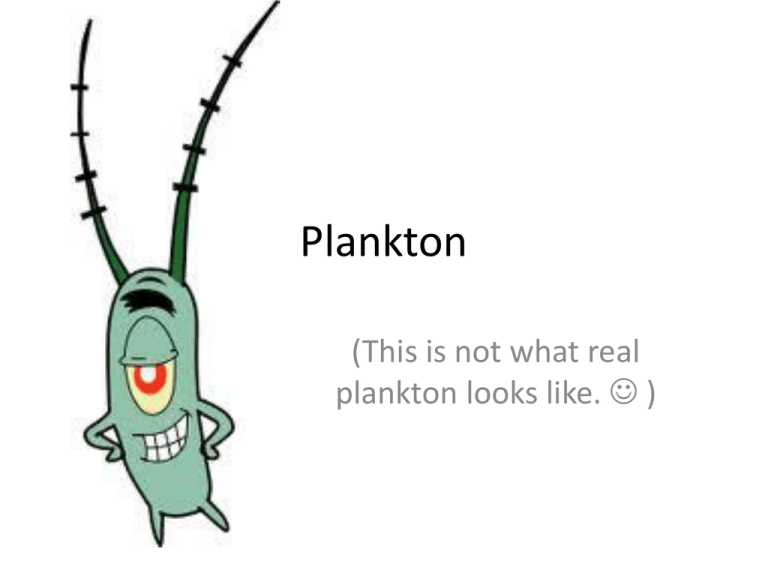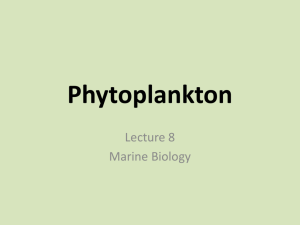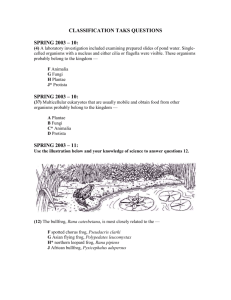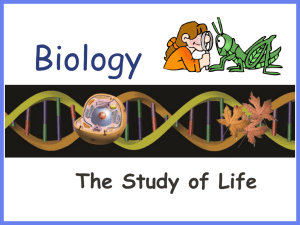Plankton
advertisement

Plankton (This is not what real plankton looks like. ) • From the Greek word “planktos” meaning to drift – They cannot swim against a current The Base of the Ocean Food Web • Plankton can be in any of the kingdoms of life – Archaebacteria – Bacteria – Protista – Fungi – Plantae – Animalia • Holoplankton: organisms that are plankton their entire lives – Example: Diatoms • Meroplankton: organisms that are plankton for only part of their lives – Example: Starfish Phytoplankton • Obtain food through photosynthesis • Converts CO2 and water to O2 and sugar – Sunlight is the energy source that powers this • 70-80% of the world’s oxygen is produced by phytoplankton • Phytoplankton live primarily in the euphotic and photic zones because they rely on the sunlight DIATOMS • Kingdom Protista – They are a type of algae (singular is alga) • They have cell walls made of silica – Material in glass • Very beautiful when viewed under a microscope Diatoms Continued • The glassy shell is called a frustule – Has two halves and resembles a box Diatom Reproduction Frustules get smaller and smaller. Usually asexual reproduction Dinoflagellates • Kingdom Protista • Two flagella • • • • – one wrapped around a groove along the middle of the cell – One trailing behind it for navigation Cell wall made of plates of cellulose Zooxanthellae is a dinoflagellate Causes red tides Bioluminescent species • http://www.youtube.com/watch?v=T2xh9UPSlU Zooplankton • Animal like plankton • They are heterotrophs, so they eat/absorb food into their bodies • Often eat phytoplankton Foraminifera • Sometimes called forams • Kingdom Protista • Use pseudopodia that go through pores to catch food • Their shells sink to the bottom of the ocean to form an ooze • Helps form limestone and chalk • http://www.youtube.com/watch?v=9Lm9hUj2h_ 0&feature=results_main&playnext=1&list=PL7B2 1BFCC020490B6 Famous forams Homotrema rubrum is a foram that is bright red and lives on corals. Very common in Bermuda; skeletons made the island’s famous pink beaches. Radiolarians • • • • Spherical Shells of silica Pseudopodia to eat Also makes ooze Ciliates • Many hair like extensions called cilia to move • Very common as freshwater Paramecium Zooflagellates • A flagellated organism from the Kingdom Protista • Doesn’t have a shell like dinoflagellates – Also not autotrophic Jellyfish • Kingdom Animalia • Cannot swim against current, so they are plankton • Wash up on beaches easily • We will learn a lot more about jellyfish soon Siphonophores • Kingdom Animalia • Related to jellyfish, but not exactly the same • Very long and actually made of many tiny animals • Very fragile • Most live in deep ocean – Exception is Portuguese Man of War that so many have heard horror stories about • Kingdom Animalia • Class Crustacea – Look like tiny shrimp • Very important part of food web • Especially important in Antarctic Ocean Ecosystem Krill Copepods • Kingdom Animalia (Class Crustacea) • Related to crabs and lobsters • Often parasites, but there are some that are a great source of food for fish • If you find one, don’t be worried it’s a parasite because those need to be attached to something else to stay alive • Two main parts of body and two large antennae




